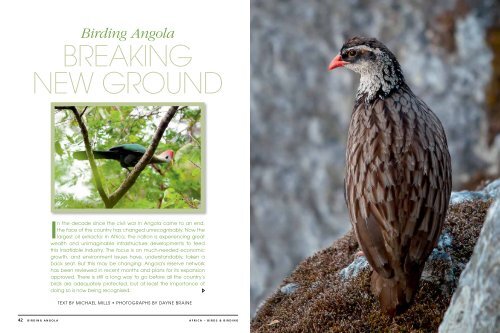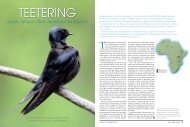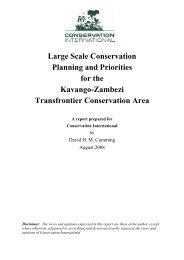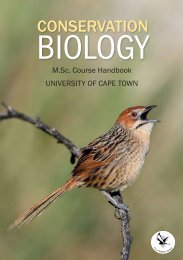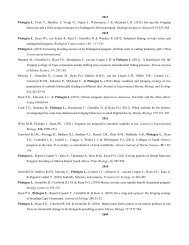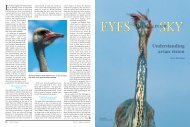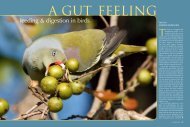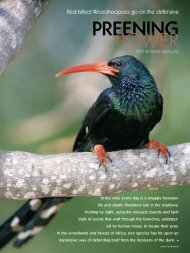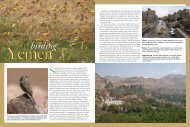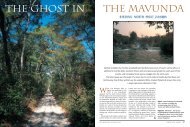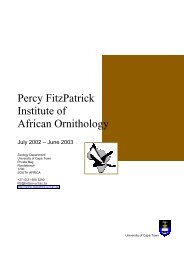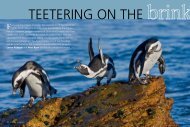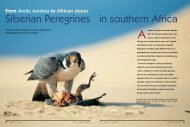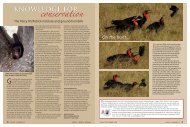Birding Angola - Percy FitzPatrick Institute of African Ornithology
Birding Angola - Percy FitzPatrick Institute of African Ornithology
Birding Angola - Percy FitzPatrick Institute of African Ornithology
Create successful ePaper yourself
Turn your PDF publications into a flip-book with our unique Google optimized e-Paper software.
<strong>Birding</strong> <strong>Angola</strong>breakingnew groundIn the decade since the civil war in <strong>Angola</strong> came to an end,the face <strong>of</strong> the country has changed unrecognisably. Now thelargest oil extractor in Africa, the nation is experiencing greatwealth and unimaginable infrastructure developments to feedthis insatiable industry. The focus is on much-needed economicgrowth, and environment issues have, understandably, taken aback seat. But this may be changing: <strong>Angola</strong>’s reserve networkhas been reviewed in recent months and plans for its expansionapproved. There is still a long way to go before all the country’sbirds are adequately protected, but at least the importance <strong>of</strong>doing so is now being recognised.Text by Michael Mills • Photographs by Dayne Braine42 birding angolaAFRICA – BIRDS & BIRDING
Gabela Akalat is <strong>Angola</strong>’s most localisedendemic and is endangered mostsignificantly by forest loss resulting fromslash-and-burn farming. Fortunately it isstill common within its restricted range,although it can be hard to distinguishas it feeds unobtrusively in the forestunderstorey.To find any <strong>of</strong> the country’s14 endemics you have to venture tothe mountains and scarp in the west,which together form the core <strong>of</strong> theWestern <strong>Angola</strong> Endemic Bird AreaWhat is it about these areas that makesthem biologically unique? To find out,we need to look at climatic conditionsthousands <strong>of</strong> years ago. Congo Basin forestonce extended right down into whatis now <strong>Angola</strong> and the scarp forests areconsidered to be outliers <strong>of</strong> it, sinceCongo Basin species like Blue Malkoha,Yellow-throated Nicator, Yellow-belliedWattle-eye, Black-throated Apalis andYellow-billed Barbet supplement their ownendemic avifauna. During dry periods theCongo Basin forest contracted into thewettest refuges in Central Africa. However,the steeply rising scarp trapped moisturefrom the nearby Atlantic Ocean, allowingpockets <strong>of</strong> dry forest to persist on it evenwhen, at the driest times, the surroundingareas were covered in arid savanna.With hundreds <strong>of</strong> kilometres separatingthe pockets <strong>of</strong> scarp forest from thenearest similar vegetation, some residentbirds evolved in isolation, slowly changinginto unique, endemic species. As thearea has become moister in recent times,these dry forests and thickets appear tohave spread into adjacent areas along thecoastal plain, with the result that speciesthat may have evolved in them, such asRed-backed Mousebird, Pale-billed Firefinch,White-fronted Wattle-eye, <strong>Angola</strong>Batis, Golden-backed Bishop and PaleoliveGreenbul, are now more widespread.Among the true forest endemicsare the striking Red-crested Turaco, thesecretive Grey-striped Francolin, the unobtrusiveGabela Akalat, two dull forestwarblers (Pulitzer’s Longbill and Hartert’sCamaroptera) and a quartet <strong>of</strong> impressivebush- and helmet-shrikes (Gabela, Braun’sand Monteiro’s bush-shrikes and GabelaHelmet-Shrike). These birds are the mainreason for birders to visit <strong>Angola</strong>.Asimilar scenario <strong>of</strong> climateinfluencedfluctuations in habitat distribution is thought tohave affected the BailundoHighlands, although the vegetation thatnow occurs there may have been morewidespread in cooler and drier epochs. Repeatedcycles <strong>of</strong> warming and cooling, andthe associated contraction and expansion<strong>of</strong> afromontane forest and grassland, haveleft a strange assemblage <strong>of</strong> birds in these,the most isolated highlands in Africa.The avifauna here includes some montanespecies that appear to be identical tothose <strong>of</strong> other mountainous areas, suchas <strong>African</strong> Olive-Pigeon, Thick-billedSeedeater, Bar-tailed Trogon and OrangeGround-Thrush. Some birds, however,have evolved to become distinct enoughto be recognised as endemic subspecies:the koesteri form <strong>of</strong> Ruwenzori Nightjar,the angolensis form <strong>of</strong> Western GreenTinkerbird, the cinerovinacea form <strong>of</strong>Dusky Twinspot, the grandis form <strong>of</strong> GreyApalis and the gadowi form <strong>of</strong> Bronzy Sunbirdare in this group. Although differentfrom their closest relatives in the AlbertineRift, Cameroon Highlands or Eastern ArcMountains, they have not changed sufficientlyto be considered species in theirown right.Finally, and most significantly, there isa group <strong>of</strong> endemic species that have beenisolated long enough to have evolvedinto distinct species. It includes the EndangeredSwierstra’s Spurfowl, a speciesrecorded by fewer than 20 birders, as wellas <strong>Angola</strong> Slaty Flycatcher, <strong>Angola</strong> SweeWaxbill, Ludwig’s Double-collared Sunbirdand the unique <strong>Angola</strong> Cave Chat,in a genus <strong>of</strong> its own. These highland specialsare joined by a host <strong>of</strong> other localisedspecies, some <strong>of</strong> which are shared withwestern Zambia. The local Black-collaredBulbul, Bocage’s Akalat, <strong>Angola</strong> Lark andPerrin’s Bush-Shrike are in this group.Their unique evolutionary historiesnotwithstanding, the scarpand montane forests fall entirelyoutside <strong>Angola</strong>’s protected areanetwork, putting the rare endemic birdsthey contain in grave danger <strong>of</strong> extinction.The afromontane forest is morethreatened, due to its tiny extent; untilAbove The distinctive <strong>Angola</strong> Cave Chat isone <strong>of</strong> the country’s endemics, and the onlyone to be placed in its own genus.Left <strong>Angola</strong> Lark is one <strong>of</strong> the nearendemicbirds shared with Zambia andsouthern Democratic Republic <strong>of</strong> Congo. Itoccurs in grassland on the inland plateauand is common around the base <strong>of</strong> MountMoco, where it is most easily located by itsmelodious song.46 birding angola AFRICA – BIRDS & BIRDINGdecember 2011/january 2012 birding angola 47
The contraction andexpansion <strong>of</strong> afromontaneforest and grassland haveleft a strange assemblage<strong>of</strong> birds in these, the mostisolated highlands in AfricaAbove The isolated montane areas <strong>of</strong><strong>Angola</strong> are separated from similar habitatsby more than 2 000 kilometres and supportpopulations <strong>of</strong> typical montane species suchas this Grey Apalis.Right Black-throated Apalis is one <strong>of</strong> theCongo forest birds that has followed theextension <strong>of</strong> Congo-type forest that runsalong the <strong>Angola</strong>n escarpment. It occurs inKumbira Forest alongside the central scarpendemics.Below and opposite Black-collared Bulbul(below) and Bocage’s Akalat (female shownopposite) inhabit highland forests and arealso found in western Zambia.louise brainerecently, the largest known patches <strong>of</strong> thisforest type covered 85 hectares at MountMoco, the country’s highest mountain. Inthe past 18 months, however, new areashave been explored by means <strong>of</strong> GoogleEarth satellite imagery and field surveys,and significant pockets <strong>of</strong> afromontaneforest, containing all the habitat’s endemicbirds, have been discovered in the NambaMountains. These finds have trebledthe known extent <strong>of</strong> afromontane forestin <strong>Angola</strong>. While there is considerablymore scarp forest, most <strong>of</strong> it is extremelydegraded and under great pressure fromthe very high density <strong>of</strong> the local humanpopulation. Swift and decisive conservationaction is vital if these areas are to besaved.With the primary aim <strong>of</strong> safeguardingthese most threatened habitats, BirdLifeInternational and now BirdLife South Africahave been supporting research andconservation in <strong>Angola</strong> since 2009, helpedby funding from organisations such as theA.P. Leventis Ornithological Research <strong>Institute</strong>,the Rufford Small Grants Foundation,the Conservation Leadership Programmeand the <strong>African</strong> Bird Club. Initiatives currentlyunder way are establishing a conservationpresence at Mount Moco in thehighlands and at Kumbira Forest along thecentral scarp, which is an even more importantsite for endemics.These small-budget projects work withcommunities to make them aware <strong>of</strong> environmentalissues and to change the waythey use natural resources. It is hoped that,in the long run, income from communitybasedecotourism will provide a significantincentive for people to conserve the scarpand afromontane habitats, and that the<strong>Angola</strong>n government will afford them <strong>of</strong>ficialprotection. Another goal is to buildcapacity among local institutions so thatthey will be able to carry out this work independently.Ultimately, both initiativesaim to ensure the long-term persistence <strong>of</strong>all <strong>Angola</strong>’s special birds.Know before you go<strong>Angola</strong> is not an easy country to visit.For most nationalities the first hurdle,and a substantial one at that, is to obtainan entry visa (luckily for Namibians, thisexcludes you). Contact your local <strong>Angola</strong>nembassy or consulate to find out whatis required. In South Africa there is anembassy in Pretoria and consulates inJohannesburg and Cape Town (www.angola.visahq.com). Visa applicationstake five working days to process in SouthAfrica, but may take up to eight weeksin other countries.TRANSPORTThe next consideration is how to getaround and the relative costs. Unless youhave connections in <strong>Angola</strong>, the bestoption is to drive in from Namibia andbe completely self-reliant, although thisshould be attempted only by experiencedAfrica travellers. Another possibility is totake a fully guided tour with an expertcompany such as <strong>Birding</strong> Africa (www.birdingafrica.com). A third option is to flyto Luanda and pay upward <strong>of</strong> R3 000 perday for an all-inclusive package <strong>of</strong> transport,meals and camping. (Although newhotels are opening up around the country,they are usually far from the best birdinglocalities. At least for now, camping is theonly option for serious birders.)The good news is that road conditionshave improved considerably in the pastfive years, with thousands <strong>of</strong> kilometres <strong>of</strong>new tar making travel much easier thanbefore. Nevertheless, a 4x4 is essential forgetting to the best birding sites, as are aGPS and good maps (try Tracks4Africa atwww.tracks4africa.co.za). And don’t forgetthat you drive on the right in <strong>Angola</strong>.RESOURCESThere is no field guide specifically for <strong>Angola</strong>,and the only guides that cover all thecountry’s birds are Birds <strong>of</strong> Africa South <strong>of</strong>the Sahara (Sinclair & Ryan; Struik Nature)and Illustrated Checklist: Birds <strong>of</strong> SouthernAfrica (Van Perlo; Collins); neither <strong>of</strong> theseis sufficient for identifying the more trickyspecies. Birds <strong>of</strong> Western Africa (Borrow &Demey; Helm) will be useful to visitors tothe north <strong>of</strong> the country.The Birds <strong>of</strong> <strong>Angola</strong> (Dean; BritishOrnithologists’ Union) gives informationon distribution, abundance and breeding;copies can be obtained from birdsangola@gmail.comSouthern <strong>African</strong> Birdfinder (Cohen,Spottiswoode & Rossouw; Struik) givessome information on where to watchbirds, but the coverage is not extensive.Some issues <strong>of</strong> Bulletin <strong>of</strong> the <strong>African</strong>Bird Club carry articles on birding inspecific areas <strong>of</strong> <strong>Angola</strong> and on speciessuch as Swierstra’s Spurfowl, Braun’s Bush-Shrike and Black-tailed Cisticola.The websites www.birdsangola.org andwww.mountmoco.org may also be useful.For birdcalls, the country-specific Vocalisations<strong>of</strong> <strong>Angola</strong>n Birds (Mills; Birds<strong>Angola</strong> and <strong>Birding</strong> Africa) has recordings <strong>of</strong>most <strong>of</strong> the endemics and specials, and canbe combined with Southern <strong>African</strong> BirdSounds (Gibbon; Southern <strong>African</strong> <strong>Birding</strong>)and <strong>African</strong> Bird Sounds: West and CentralAfrica (Chappuis; British Library NationalSound Archive) for near-complete coverage.48 birding angola AFRICA – BIRDS & BIRDINGdecember 2011/january 2012 birding angola 49


